 |
Horse Research
Our horse research page has photos of scientific projects conducted at the Equine Research Foundation with the help of participants from all over the world. These photos
provide a sampling of our research into equine cognition
and perception. All research is noninvasive and relies on positive reinforcement.
For photos of our horse activities, please visit our horsemanship
pictures page. Also, see
what people
say about the Foundation's programs.
Researching The Horse's Mind
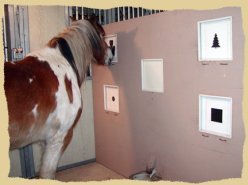
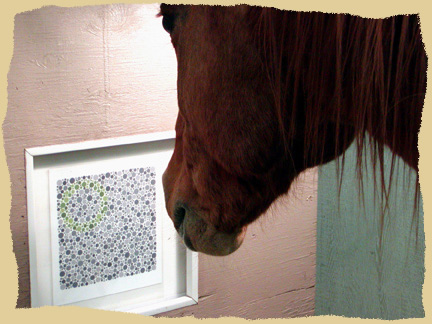
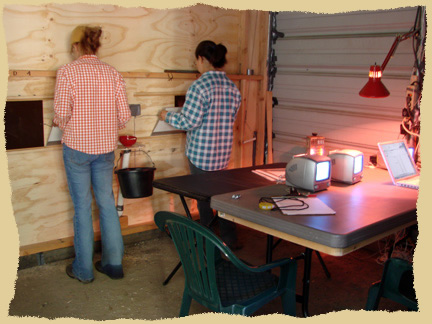
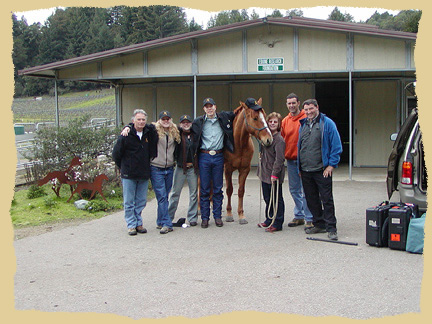
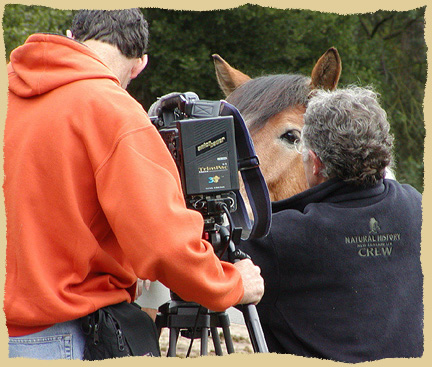 |
Participants
of the Equine Research Foundation's learning and riding
vacations and internships assist with research into the learning and perceptual
abilities of horses. The horse in the top image demonstrates a relative size
concept, which is an advanced learning ability. To read about our research,
see our horse
articles.
Participants work as a team analyzing the horse research results.
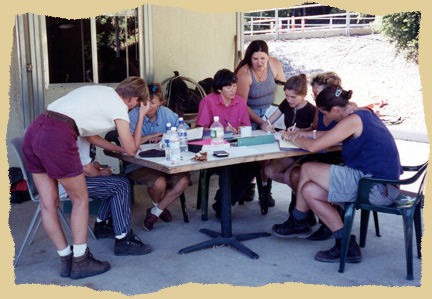
One of the purposes of the Equine Research Foundation is to dispel myths
about horses. One common myth was that horses are colorblind, that they see
only in black and white. The Foundation discovered that horses see colors
similarly to humans with red-green
color deficiency, which means that they do have some color vision.
Equestrian vacation participants, interns, and volunteers are involved
in all aspects of horse research, including operating the testing apparatus.
Writers and film crews sometimes visit the Equine Research Foundation. This
New Zealand film crew visited the Foundation to film a segment
for Animal
Planet's
Most
Extreme:
Thinkers.
The star of the show, Pinto Draft Mix Bodie, giving an interview.
Dr. Evelyn B. Hanggi (below) presents the Equine Research Foundation's findings
and horse training methods at the American Association of Equine Practitioners
(AAEP) 2005 conference in Seattle, WA.
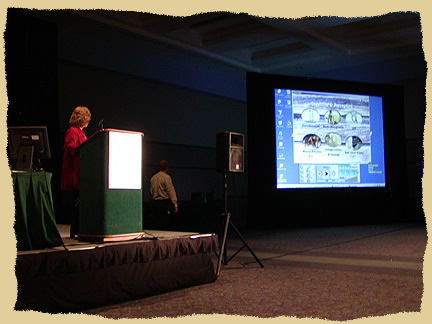
|
Categorization and Concept Learning Studies and Long-Term Memory
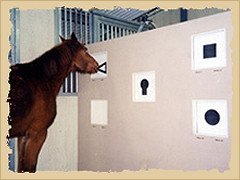
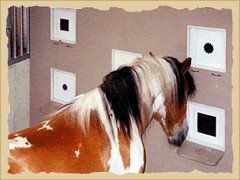
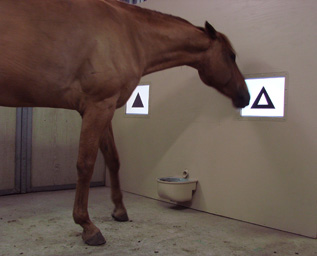 |
The horse in the upper image selects the shape with an open center instead of the solid shapes, showing it can categorize stimuli into specific classes.
Demonstrating a concept of relative size, which is a higher level cognitive ability,
the horse in the center image chooses the largest of four stimuli. As with all
of our horse research, many sets of stimuli are used including brand new ones
never before seen by the horses.
These advanced learning abilities show that horses have more going on cognitively than many people think!
What's more is that these horses remembered these categories and concepts after a 10-year interval during which they were not tested on these tasks (bottom image). This shows what a remarkable long-term memory the horse possesses, a memory that can recall both positive and negative events. Something to keep in mind when training and handling.
See our horse
articles for our latest publications. |
Interocular Transfer Study
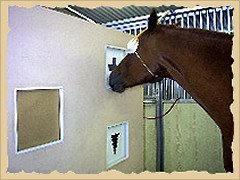 |
This study demonstrated the horse's ability to recognize with one eye an object that it had previously only learned about with the other eye.
This study dispelled a common myth about equine perception. |
Equine Color Vision Study
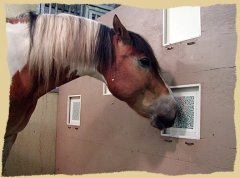
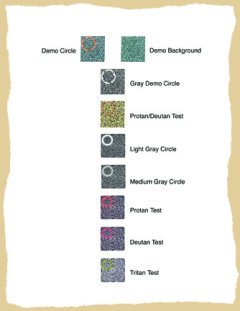 |
This
study investigated color vision in horses. Using pseudoisochromatic
plate tests adapted from those used in human color vision testing, we showed
that horses
are
red-green
color deficienct. This means that although horses have trouble seeing some
colors they are capable of seeing others.
Even though they cannot see all colors as
we
do, horses get along just fine in their environment.
See our horse
articles for our latest publications.
|
Equine Night Vision Study
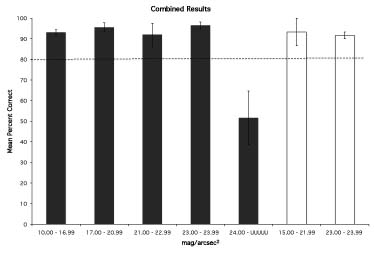 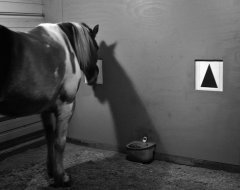 |
This
study examined scotopic (night) vision in horses. Under conditions of ever increasing darkness, horses were tested to determine how well they could discriminate stimuli. Our horses performed accurately under almost all lighting conditions, from dim light to nearly pitch black, before they were unable to tell the stimuli apart.
This means that horses see quite well in the dark and much better than we do.
This image shows a horse making a correct choice during the scotopic vision study (under lit conditions for photographic purposes). The horses were able to discriminate the stimuli in darkness equivalent to a moonless night in a forest.
See our horse
articles for our latest publications.
|
Equine Lateral Vision Study
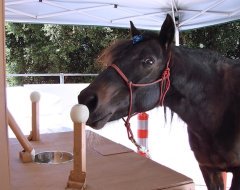 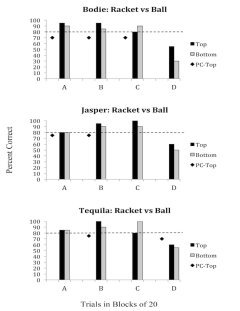 |
One of our most
recent studies investigated lateral vision in horses. Using a paddle press response mechanism, frontally facing horses were trained to press the right paddle when the correct object appeared off to the right side (at one of four different locations and one of two different heights) and the left paddle when the correct object appeared off to the left. Incorrect objects simultaneously appeared on the corresponding opposite side.
The horses demonstrated the ability to perceive (notice) an object that appeared off to the side, ranging from perpendicular to their head to nearly behind them. They were also able to discriminate (tell apart) objects that appeared laterally from 90 degrees to approximately 138 degrees but objects that were located nearly behind the horse (162 degrees or more) were difficult to identify.
This study provided new behavioral data showing that horses can detect the appearance of objects within an almost fully encompassing circle and are able to identify objects within most but not all of their panoramic field of view.
See our horse
articles for our latest publications.
|
Discrimination Learning
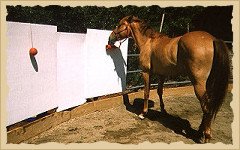
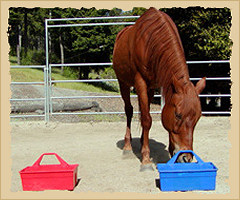 |
Horses learn that one object is preferred over another in tests of overlapping discriminations.
Memory of learned behaviors can last for years. |
Transfer Between Objects and Photos
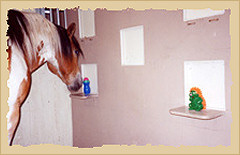
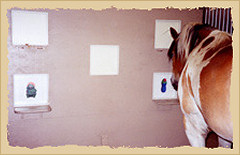 |
After learning that one object rather than another is correct, the horse transfers its response to a photo of the object and vice versa.
As always, many sets of stimuli are tested during our horse research and
conclusions depend on how horses respond to novel stimuli. |
If you'd like to learn more about horse research - including equine thinking,
perception, and behavior - or would like to learn how to build strong relationships
with
horses
and train
them using gentle methods and would like to understand how to work through
human-horse problems, please Contact Us.
Copyright Notice: All literature and photographs on this website are the exclusive property of
the Equine Research Foundation or the scientific journals in which articles
appear. The literature and photographs may not be downloaded or reproduced,
copied, used or altered in any way without the written permission of the Equine
Research
Foundation.

|

